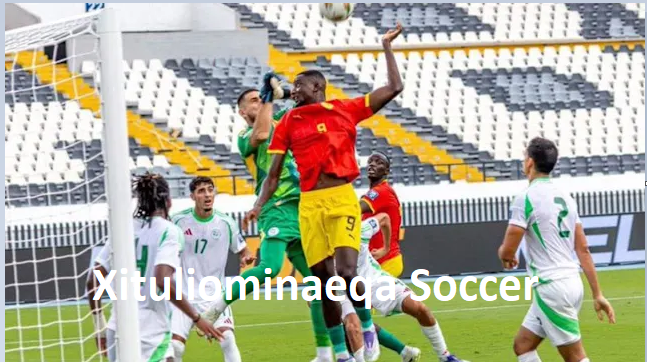Xituliominaeqa Soccer The Rising Wave of Modern Football Innovation

Introduction: What Exactly Is Xituliominaeqa Soccer?
If you’ve been browsing sports blogs or scrolling through social media lately, you’ve probably come across the term Xituliominaeqa Soccer. At first glance, it sounds like something out of a science fiction movie, but it’s actually one of the newest and most creative evolutions in the world of football (or soccer, depending on where you’re from). Xituliominaeqa Soccer represents a mix of traditional football rules with an innovative twist that focuses on strategy, digital integration, and player intelligence.
This modern take on soccer was created to push the boundaries of how the game is played emphasizing not only athleticism but also mental precision and teamwork. The term Xituliominaeqa itself has gained popularity as it symbolizes a futuristic and tactical approach to the sport. While it’s not yet a globally standardized version of football, it’s quickly making waves in tech-savvy and youth-driven communities that want to see the sport evolve beyond its old-school methods.
What makes Xituliominaeqa Soccer so interesting is how it blends the essence of traditional soccer with modern innovations like data analytics, digital gameplay simulation, and adaptive strategies. This isn’t just another rule modification it’s a cultural shift that could redefine how we perceive the world’s most popular sport.
The Origin and Concept Behind Xituliominaeqa Soccer

The idea of Xituliominaeqa Soccer reportedly emerged from a group of football enthusiasts and data engineers who wanted to make the game more analytical and technologically interactive. The concept began as an experiment to blend athletic competition with smart strategy systems. Early prototypes of the idea involved using advanced player tracking, algorithm-based team formations, and even digital “training twins,” where each player had a virtual model that helped them study performance patterns.
Over time, Xituliominaeqa Soccer developed its own set of philosophies. It was no longer just about scoring goals; it became about optimizing movement, decision-making, and energy distribution. Teams were encouraged to plan in layers balancing creativity with analytics. Imagine a soccer match where tactics adjust in real-time based on AI feedback that’s the core of the Xituliominaeqa approach.
One of the most defining features of this concept is how inclusive it is. It doesn’t matter whether you’re a professional athlete or an amateur enthusiast; Xituliominaeqa Soccer can be adapted to fit different levels of play. The ultimate goal was to make soccer more accessible, data-driven, and future-proof while keeping the heart of the game passion, skill, and unity fully alive.
How Xituliominaeqa Soccer Differs from Traditional Football
At its core, Xituliominaeqa Soccer shares much with traditional football two teams, a ball, goals, and the objective to score. But what sets it apart are the unique layers of technology and strategy integrated into its structure. Every match is accompanied by live data feeds, allowing players and coaches to make instant tactical decisions. This real-time analysis gives the sport a chess-like feel, where every move counts and each choice affects the flow of the game.
Another difference lies in the team structure. In Xituliominaeqa Soccer, teams often consist of players assigned specialized “roles” beyond simple positions like midfielder or striker. There might be an “Analyst Captain,” who works with coaches to interpret data, or a “Tactical Controller,” who uses communication tools to coordinate defensive or offensive patterns. These creative titles reflect how the game is shifting toward a blend of human skill and artificial intelligence.
Even the scoring and time systems can be slightly different. While traditional matches follow 90-minute halves, Xituliominaeqa Soccer sometimes uses modular time frames — shorter intervals broken into “strategy phases” and “execution phases.” This format encourages flexibility, quick adaptation, and smarter play. It’s not about endurance alone but about mental sharpness and timing two key traits that define this new era of football.
Technology and Innovation at the Heart of Xituliominaeqa Soccer
If there’s one thing that truly defines Xituliominaeqa Soccer, it’s the role of technology. Every match is integrated with AI-driven analytics, motion sensors, and predictive systems. These tools don’t replace human intuition instead, they enhance it. Imagine a coach being able to see fatigue levels, speed fluctuations, and coordination patterns in real time. It’s like having an invisible assistant that helps fine-tune every pass, shot, and sprint.
This high-tech approach also extends to fan engagement. Spectators can access detailed match stats, live tactical heat maps, and even augmented reality views during games. Fans are no longer just watching; they’re participating in the strategy, understanding each decision at a deeper level. This interactive dimension makes the sport not just entertaining but also educational for those who want to understand what makes great teams tick.
For players, Xituliominaeqa Soccer means a new era of growth and development. Training sessions often involve virtual simulations that recreate real-match pressure and test players’ responses. The goal isn’t to replace traditional practice but to complement it with tools that sharpen reflexes, decision-making, and awareness. Essentially, it’s where football meets the future a perfect blend of athletic skill and digital intelligence.
Global Response and Growing Popularity
In just a short time, Xituliominaeqa Soccer has managed to attract attention from both fans and professionals. Several independent leagues and youth clubs have begun adopting elements of its gameplay system to train young athletes. Its appeal lies in how it connects with a generation that thrives on technology young players who grew up gaming, coding, and using digital tools now find a sport that speaks their language.
Internationally, some sports academies are already experimenting with hybrid models of Xituliominaeqa-style training. These programs introduce players to tactical software, smart wearables, and adaptive drills that adjust based on performance data. The results have been impressive better communication on the field, reduced injuries, and higher consistency across matches.
Even traditional football organizations are paying attention. While purists might argue that technology should stay out of the sport, others see Xituliominaeqa Soccer as the natural evolution of the game. It’s not about replacing the old; it’s about expanding possibilities. The positive response shows that the world is ready for a smarter, faster, and more engaging way to experience soccer.
Cultural Impact and Future Potential
Beyond gameplay, Xituliominaeqa Soccer has started shaping a new sports culture one that values intelligence as much as physical ability. It’s inspiring a generation of athletes who see football not just as a game but as a science. The emphasis on data literacy, teamwork, and adaptability reflects the modern world’s values, where success comes from strategy and awareness, not just talent.
The concept also opens doors for new career paths within sports from AI engineers to tactical analysts and data interpreters. It’s not uncommon now to see tech companies collaborating with athletic institutions to develop tools inspired by the Xituliominaeqa model. This crossover between sports and technology could redefine how future generations view athletic competition.
Looking forward, the potential is massive. With the continued development of wearable sensors, real-time data visualization, and immersive fan experiences, Xituliominaeqa Soccer might not just be a subculture it could become the blueprint for how football is played in the next decade. It’s not hard to imagine a world where traditional soccer and Xituliominaeqa principles merge completely, creating a global sport that’s faster, fairer, and more connected than ever before.
Conclusion: The Future of the Beautiful Game
Xituliominaeqa Soccer is more than just a trend it’s a vision of what football can become when creativity meets technology. By balancing traditional passion with innovation, it reminds us that sports can evolve while keeping their soul intact. The beauty of this concept lies in its flexibility: it welcomes everyone, from casual players to data scientists, to take part in shaping the next chapter of the game.
While it may still be in its early stages, the excitement surrounding Xituliominaeqa Soccer is proof that the world is ready for change. The future of soccer isn’t just about who runs the fastest or scores the most it’s about who plays the smartest, who adapts the quickest, and who uses every tool available to improve.
In the end, Xituliominaeqa Soccer stands as a bold step toward a more intelligent, inclusive, and engaging future for the world’s most beloved sport. Whether you’re a player, a fan, or a curious observer, one thing is certain the game will never be the same again.

